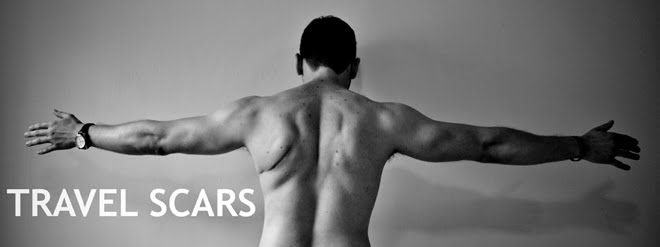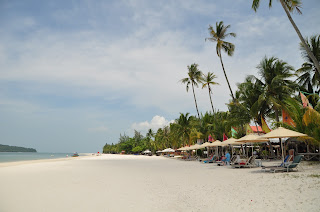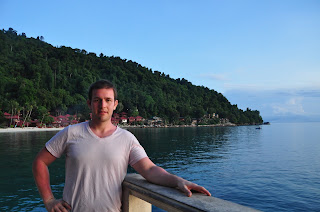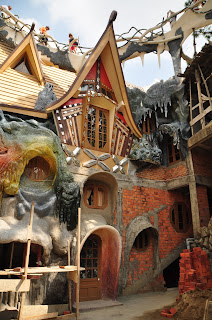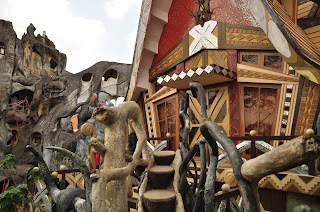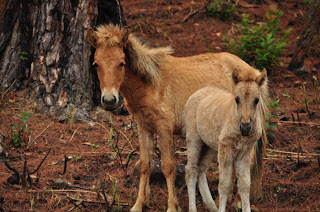As I made my way to Saigon's public bus terminal through the ever-bustling Cong Vien Van Hoa Park, I stopped when I noticed a Caucasian jogger coming towards me. I couldn't believe it, but it was John, an American I had met on my first day in Cairo. He was currently living in Ho Chi Minh City and training before he went to a Muay Thai camp in northern Thailand the following month.
It had been over 8 months since we had initially met and to see each other at this exact time and place really blew our minds. It never ceases to amaze me how small our world really is!
I then took the bus to my stop and thanks to a Vietnamese pilot also headed for the airport, I was ushered to the connecting bus to the international terminal.
My next destination was peninsular Malaysia to reunite with Mike following his travels in Cambodia and to meet up with my friend Yagil.
Yagil and I have been friends since Cegep (Quebec College), and I personally take credit for introducing him to the wonderful world of partying.
Since that time, we have studied together at McGill University in Physical Therapy; and travelled together to Niagara Falls, New York City, Boston, North and South Carolina; and even in Turkey.
He was looking for an exotic location and I thought Malaysia would be a suitable place to meet up because it has beautiful beaches, historical landmarks, outdoor activities; while still having good infrastructure and western amenities that would not throw him too off guard.
While Yagil and I are very different travellers: I prefer backpacking and he prefers more luxurious holidays; we decided to compromise and find things that pleased us both.
Good Luck!
Our first stop was Palau Langkawi, peninsular Malaysia's duty-free island, and closest thing Malaysia has to a party spot.
Even though the three of us were flying in from different countries, we all had a seat booked on the flight from Kuala Lumpur to Langkawi.
We arrived to Langkawi after dark and took a taxi-van to Zackry Guest House on Pentai Tengah. We then moved our stuff into our private room and joined some other guests for some beers.
Malaysia, being a moderately conservative Muslim country, has comparatively high taxes on alcohol and as a consequence, it is quite more expensive to drink than in the rest of South East Asia.
However, Langkawi has had a duty-free status since the 80's to increase tourism and as a result is the cheapest place to drink in Malaysia.
Party on!
After eating dinner and listening to the Malay-Samoan-Kiwi hostel employee run his mouth for over an hour, we made our way to a beach-side bar/club before heading to Sunba Retro Bar, a packed place with a really decent band.
The next day, after a late breakfast, we joined Andreas, a German traveller, and took a taxi to Langkawi's impressive cable-car located at Gunung Mat Chin Chang.
Despite my aversion to cable-cars in China, this one allowed us to see spectacular views over the archipelago of 99 islands and even see Thailand from the top!
We then went to Seven Wells, a series of natural pools where we could cool off after climbing the hundreds of stairs to get to them. We also spent a brief time watching locals flipping into the pools trying to impress us.
After spending the rest of the afternoon at Tengah beach, we partied with the best of em after playing drinking games at the hostel and then hitting up the same places as the night before, only in reverse order.
We had an evening boat to catch so we spent our last day in Langkawi on the surprisingly beautiful Pentai Cenang. To be honest, I think that this beach was the best maintained and pristine since arriving in South East Asia. Sorry secret beach in Koh Rong, you've been knocked down a spot!
Andreas joined us on the ferry to Penang, our next island destination on Malaysia's west coast. The ferry itself only took 2 hours and then we proceeded to walk through the historic centre of Georgetown to get to our heritage-home guest-house, Red Inn Heritage (redinnheritage.com).
Despite most restaurants being closed, we still managed to find one of Malaysia's famous Hawker stalls: pretty much a late-night food court selling some of the best and cheapest food that Malaysia's Malay, Chinese and Indian inhabitants have to offer.
Georgetown, located on the north-eastern coast of Pulau Penang was founded in 1786 by the British and was one of their three initial straights settlements with Melaka and Singapore. It has been a UNESCO World Heritage site since 2008 and still has many of its historic buildings and charm intact.
We commenced a self-guided walking tour, passing the cathedral of the assumption and St. George's church, said to be the oldest Anglican church in Southeast Asia, having been built in 1817.
We then spent an hour in the Penang State Museum to get a history lesson about Georgetown and its multi-ethnic population.
A short walk down the seaside esplanade led us to the remnants of Fort Corwallis and the city and town halls.
The next part of the tour brought us through Chinatown with its narrow, ornate alleyways and some beautiful street art.
We visited the beautifully decorated exterior and uninspiring interior of the Hainan Temple built in 1895, strolling past the Masjid Malayu Lebuh Acheh, built for Georgetown's Arab settlers.
We then stumbled across Khoo Kongsi, a fantastically decorated clan house belonging to the Khoo Kongsi Klan, who we hilariously convinced Yagil started the KKK in North America.
We had some delicious samosas in Little India before visiting the Goddess of Mercy Temple and strolling back along the quaint streets of Georgetown before reaching our guesthouse back on Love Lane.
A hostel employee had promised us a free tour of Penang the following day, but had slept until noon and completely forgot about us. We decided to visit Kek Lok Si Temple, the largest temple in Malaysia instead.
The complex is located on a hill and is as imposing as it is beautiful. To reach the seven-storied Ban Po Thar Pagoda, we had to walk up several staircases, past turtle ponds and hundreds of Buddhas.
After, we took a cable car to the immense 36.5m bronze statue of Kuan Yin, housed in an even larger frame. This was the first time I actually heard Mike say something actually impressed him. From up there we got some nice views of Air Itam and the surrounding hills.
Yagil and I arranged to take a night bus to Kuala Besut, the launching point to the spectacular Perhentian Islands. The bus we got was spacious and incredibly well air-conditioned. It didn't even matter that we had to share it with a group of travelling American Christian Missionaries.
Things were too good to be true when halfway through we had to change buses because of an air-con problem obviously felt by everyone but us, and we were put on another bus with way worse air-con and who dropped us off in Kota Bharu, a two-hour drive from Kuala Besut!
We were forced to pay for a taxi with a German guy which dropped us off at our intended destination. The only consolation was the absolutely incredible sunrise we saw over Kuala Besut.
Eventually, we caught a speed boat to Palau Kecil and settled into our long beach accommodation. It was hilarious to watch Yagil's reaction to every wave we hit on our surprisingly fast boat.
The Perhentian Islands are blissful, laid-back backpacker havens. Their beautiful beaches and shisha/fire-show evenings were beyond divine. The Perhentians, much like Thailand's Koh Tao, are renown for cheap and beautiful diving.
Our first day consisted of us chilling out at Long Beach and me trying to teach Yagil how to snorkel. My instructing him consisted of telling him to breathe through his mouth while keeping his head underwater. That's all there is to it!
The next day, Mike and I went diving with Turtle Bay Divers (www.turtlebaydivers.com), where after countless attempts, I finally saw sharks while diving in Southeast Asia! I saw a coral cat shark and a black tip reef shark. Take that Koh Tao!
That afternoon I did a snorkeling trip with Yagil and saw turtles, black tip reef sharks and it was successful because Yagil didn't drown and I didn't have to rescue him!
Our final night we went to Coray Bay for dinner and enjoyed another relaxing evening on the beach.
Because of Yagil's relatively short schedule (only 12 days), this portion of our trip together was the slower, more laid-back part, allowing us to stay a mere 2 nights in each place. From here, we would only be staying in each city for one night before heading to the next one.
Let the race begin!
